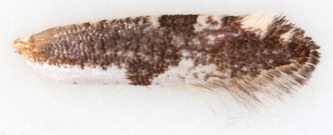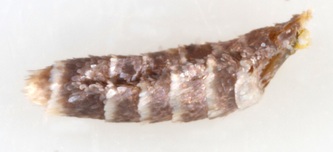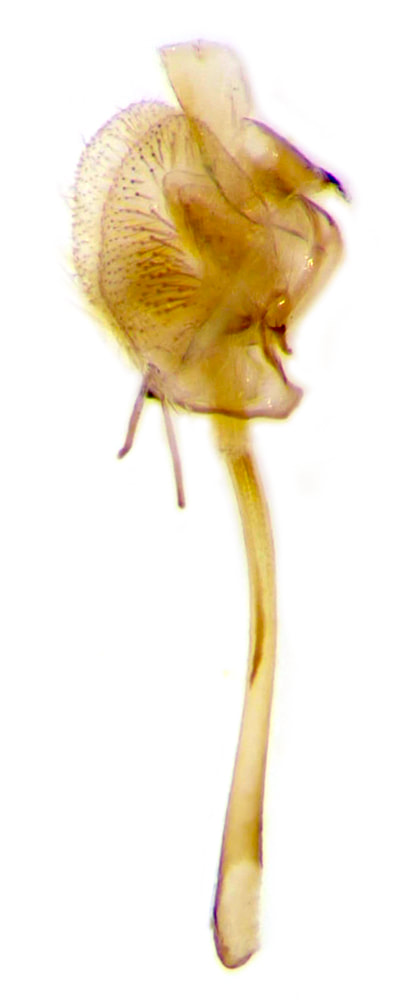20.018 Argyresthia (Argyresthia) spinosella (Blackthorn Tip Moth)
ws: 9-11mm; Jun-Jul; blackthorn (Prunus spinosella); common in England and Wales, less common in S&C Scotland, absent from N Scotland
ID: forewing not unicolorous; basal 1/3 not entirely white; white dorsal streak not interrupted in basal 1/3 (key in MBGBI3 is confusing here as alternative to this couplet is "dorsal streak interrupted at 5/12" both options seem to fit this and similar species); without second white streak in fold; dorsal streak not continuous to tornus; dorsal streak terminated by a dark spot which is not clearly continued into a fascia; ws<11mm; pronounced whitish costal strigulae, not flying beyond mid-July > A.spinosella
A.glaucinella averages smaller (ws 8-10mm). It has a median fascia slightly darker than the rest of the wing. Its thorax is pale shining brassy and the tegulae purplish fuscous not contrasting with forewing. A.spinosella has a purplish brown mark interrupting the white dorsal streak in the position of a median fascia but this mark does not extend across the wing its costal edge merging with the purplish fuscous general colour of the forewing. The thorax is white and the tegulae golden brown, contrasting with the purplish fuscous colour of the forewing.
A.conjugella is usually larger (ws 10-14mm). Its ‘white’ areas (head, thorax and dorsal streak) are all tinged ochreous. Its tegulae are deep purplish brown, not contrasting much with the purplish brown colour of the forewing. It has several dark purplish fuscous markings not shown by A.spinosella: an oblique fascia leading from the dorsal mark distally towards the costa (but not usually reaching it); a costal spot opposite the dorsal spot (in the position of a median fascia, but the purplish fuscous colour between the costal and dorsal spots is paler so the ‘median fascia’ is incomplete); and a basal streak edging the basal third of the dorsal streak. It also has a discrete whitish preapical costal spot.
A.semifusca is also usually larger (ws 10-13mm). There is little overlap in flight season – late Jun to early Sep in A.semifusca, Jun to early Jul in A.spinosella. Separated in the key in MBGBI3 by A.spinosella having more pronounced white costal strigulae and in Sterling and Parsons by A.spinosella having brown less contrasting (vs golden brown more contrasting) tegulae Hants moths suggests that genital dissection is required to distinguish these species but I cannot discern any differences in the male between the images at dissection group for these two species. In the female it may be that in a skyline view the signum shows a central hump in A.semifusca while this central portion is fairly flat in A.spinosella.
Both A.pruniella and A.bonnetella have the forewing white suffused cream in the costo-basal quadrant, and a distinct brown central basal streak.
A.glaucinella averages smaller (ws 8-10mm). It has a median fascia slightly darker than the rest of the wing. Its thorax is pale shining brassy and the tegulae purplish fuscous not contrasting with forewing. A.spinosella has a purplish brown mark interrupting the white dorsal streak in the position of a median fascia but this mark does not extend across the wing its costal edge merging with the purplish fuscous general colour of the forewing. The thorax is white and the tegulae golden brown, contrasting with the purplish fuscous colour of the forewing.
A.conjugella is usually larger (ws 10-14mm). Its ‘white’ areas (head, thorax and dorsal streak) are all tinged ochreous. Its tegulae are deep purplish brown, not contrasting much with the purplish brown colour of the forewing. It has several dark purplish fuscous markings not shown by A.spinosella: an oblique fascia leading from the dorsal mark distally towards the costa (but not usually reaching it); a costal spot opposite the dorsal spot (in the position of a median fascia, but the purplish fuscous colour between the costal and dorsal spots is paler so the ‘median fascia’ is incomplete); and a basal streak edging the basal third of the dorsal streak. It also has a discrete whitish preapical costal spot.
A.semifusca is also usually larger (ws 10-13mm). There is little overlap in flight season – late Jun to early Sep in A.semifusca, Jun to early Jul in A.spinosella. Separated in the key in MBGBI3 by A.spinosella having more pronounced white costal strigulae and in Sterling and Parsons by A.spinosella having brown less contrasting (vs golden brown more contrasting) tegulae Hants moths suggests that genital dissection is required to distinguish these species but I cannot discern any differences in the male between the images at dissection group for these two species. In the female it may be that in a skyline view the signum shows a central hump in A.semifusca while this central portion is fairly flat in A.spinosella.
Both A.pruniella and A.bonnetella have the forewing white suffused cream in the costo-basal quadrant, and a distinct brown central basal streak.
§2 Westcliff-on-sea, Essex; 02/07/2010; male; fw 4.9mm
§3 Westcliff-on-sea, Essex; 26/05/2011
§4 Strumpshaw Fen, Norfolk; 29/05/2012; male
§5 Folkestone Warren; 04/07/2013; female
§6 St Lawrence, Isle of Wight; 31/05/2014
§7 Westcliff-on-sea, Essex; 27/05/2018; female; fw 5.0mm
§8 Foulness, Essex; 25/05/2019; male; fw 5.2mm
§9 Foulness, Essex; 30/05/2020; male; fw 5.5mm
§10 Stour Wood, Essex; 06/06/2021
All images © Chris Lewis
§3 Westcliff-on-sea, Essex; 26/05/2011
§4 Strumpshaw Fen, Norfolk; 29/05/2012; male
§5 Folkestone Warren; 04/07/2013; female
§6 St Lawrence, Isle of Wight; 31/05/2014
§7 Westcliff-on-sea, Essex; 27/05/2018; female; fw 5.0mm
§8 Foulness, Essex; 25/05/2019; male; fw 5.2mm
§9 Foulness, Essex; 30/05/2020; male; fw 5.5mm
§10 Stour Wood, Essex; 06/06/2021
All images © Chris Lewis
Page published 30/01/2012 | §4 added 12/06/2012 | §5 (female genitalia) added and text amended 21/04/2014 | §6 added 28/01/2015 |
§7 added 10/03/2019 | §8 added 13/02/2020 | §9 added 09/06/2020 | §10 added 28/11/2021
§7 added 10/03/2019 | §8 added 13/02/2020 | §9 added 09/06/2020 | §10 added 28/11/2021

























